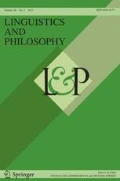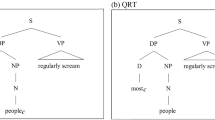Abstract
I argue that common nouns should be analyzed as variables, rather than as predicates which take variables as arguments. This necessitates several unusual features to the analysis, such as allowing variables to be modally non-rigid, and assigning their values compositionally. However, treating common nouns as variables offers a variety of theoretical and empirical advantages over a more traditional analysis: It predicts the conservativity of nominal quantification, simplifies the analysis of articleless languages, derives the weak reading of sentences with donkey anaphora, solves the proportion problem presented by quantifiers like ‘most’, improves the analysis of the temperature paradox, allows a more unified analysis of bare plurals, and regularizes the correspondence between syntactic categories and semantic types.
Similar content being viewed by others
References
Barker, C. (1996). Presuppositions for proportional quantifiers. Natural Language Semantics, 4, 237–259.
Barker, C., & Shan, C.-S. (2008). Donkey anaphora is in-scope binding. Semantics and Pragmatics, 1, 1–46.
Barwise, J., & Cooper, R. (1981). Generalized quantifiers and natural language. Linguistics and Philosophy, 4, 159–219.
Bennett, M. R. (1975). Some extensions of a Montague fragment of English. Bloomington, IN: Indiana University Linguistics Club.
Carlson, G. N. (1977a). Reference to kinds in English. Dissertation, University of Massachusetts.
Carlson, G. N. (1977b). A unified analysis of the English bare plural. Linguistics and Philosophy, 1, 413–456.
Chierchia, G. (1992). Anaphora and dynamic binding. Linguistics and Philosophy, 15, 111–183.
Chierchia, G. (1995). Dynamics of meaning: Anaphora, presupposition, and the theory of grammar. Chicago, IL: University of Chicago Press.
Chierchia, G., & McConnell-Ginet, S. (1990). Meaning and grammar: An introduction to semantics. Cambridge, MA: MIT Press.
Dekker, P. (1993). Existential disclosure. Linguistics and Philosophy, 16, 561–587.
Diesing, M. (1992). Indefinites. Cambridge, MA: MIT Press.
Dowty, D., Wall, R. E., & Peters, S. (1981). Introduction to Montague semantics. Dordrecht: D. Reidel Publishing Company.
Fara, D. G. (2015). Names are predicates. Philosophical Review, 124, 59–117.
Fox, D. (1999). Reconstruction, binding theory, and the interpretation of chains. Linguistic Inquiry, 30, 157–196.
Fox, D. (2002). Antecedent-contained deletion and the copy theory of movement. Linguistic Inquiry, 33, 63–96.
Frege, G. (1879). Begriffschrift: eine der arithmetischen nachgebildete Formelsprache des reinen Denkens. Halle: L. Nebert.
Frege, G. (1892). Über Sinn und Bedeutung. Zeitschrift für Philosophie und philosophische Kritik, 100, 25–50. English translation: On sense and reference. In P. Geach & M. Black (Eds.), Translations from the philosophical writings of Gottlob Frege (pp. 56–78). 3rd edn., Oxford: Basil Blackwell, 1980.
Gallin, D. (1975). Intensional and higher-order modal logic. Amsterdam: North-Holland.
Gamut, L. T. F. (1991). Logic, language and meaning, volume 2: Intensional logic and logical grammar. Chicago, IL: University of Chicago Press.
Gerstner-Link, C., & Krifka, M. (1993). Genericity. In J. Jacobs, A. von Stechow, W. Sternefeld, & T. Vennemann (Eds.), Syntax: An international handbook of contemporary research (pp. 966–978). Berlin: de Gruyter.
Heim, I. (1982). The semantics of definite and indefinite noun phrases. Dissertation, University of Massachusetts.
Heim, I., & Kratzer, A. (1998). Semantics in generative grammar. Malden, MA: Blackwell.
Hughes, G. E., & Cresswell, M. J. (1968). An introduction to modal logic. London: Metheun.
Jacobson, P. (1992) Antecedent contained deletion in a variable-free semantics. In C. Barker, D. Dowty (Eds.), Proceedings of SALT II (pp. 193–213). https://doi.org/10.3765/salt.v2i0.3027.
Jacobson, P. (1993). i-within-i effects in a variable-free semantics and a categorial syntax. In P. Dekker, M. Stokhof (Eds.), Proceedings of the Ninth Amsterdam Colloquium (pp. 349–386), Amsterdam: University of Amsterdam.
Jacobson, P. (1999). Towards a variable-free semantics. Linguistics and Philosophy, 22, 117–184.
Jacobson, P. (2000). Paycheck pronouns, Bach-Peters sentences, and variable-free semantics. Natural Language Semantics, 8, 77–155.
Jacobson, P. (2007). Direct compositionality and variable-free semantics: The case of “Principle B” effects. In P. Jacobson & C. Barker (Eds.), Direct compositionality (pp. 191–236). Oxford: Oxford University Press.
Jacobson, P. (2008). Direct compositionality and variable-free semantics. In K. Johnson (Ed.), Topics in ellipsis (pp. 30–68). Cambridge: Cambridge University Press.
Kanazawa, M. (1994). Weak vs. strong readings of donkey sentences and monotonicity inference in a dynamic setting. Linguistics and Philosophy, 17, 109–158.
Keenan, E. L., & Stavi, J. (1986). A semantic characterization of natural language determiners. Linguistics and Philosophy, 9, 253–326.
Kripke, S. A. (1980). Naming and necessity. Cambridge, MA: Harvard University Press.
Lappin, S., & Francez, N. (1994). E-type pronouns, i-sums, and donkey anaphora. Linguistics and Philosophy, 17, 391–428.
Lasersohn, P. (2005). The temperature paradox as evidence for a presuppositional analysis of definite descriptions. Linguistic Inquiry, 36, 127–130.
Lasersohn, P. (2011). Mass nouns and plurals. In C. Maienborn, K. von Heusinger, & P. Portner (Eds.), Semantics: An international handbook of natural language meaning, volume 2 (pp. 1131–1153). Berlin: de Gruyter.
Lasersohn, P. (2017). Subjectivity and perspective in truth-theoretic semantics. Oxford: Oxford University Press.
Lepore, E., & Ludwig, K. (2007). Donald Davidson’s truth-theoretic semantics. Oxford: Oxford University Press.
Lewis, D. K. (1975). Adverbs of quantification. In E. L. Keenan (Ed.), Formal semantics of natural language (pp. 3–15). Cambridge: Cambridge University Press.
Montague, R. (1968). Pragmatics. In R. Klibansky (Ed.), Contemporary philosophy: A survey (pp. 102–122). Florence: La Nuova Italia Editrice.
Montague, R. (1970). Universal grammar. Theoria, 36, 373–398.
Montague, R. (1973). The proper treatment of quantification in ordinary English. In K. J. J. Hintikka, J. M. E. Moravcsik, P. Suppes (Eds.), Approaches to natural language (pp. 221–242). Dordrecht: D. Reidel Publishing Company.
Putnam, H. (1962). It ain’t necessarily so. The Journal of Philosophy, 59, 658–671.
Quine, W. V. O. (1960). Word and object. Cambridge, MA: MIT Press.
Rayo, A., & Uzquiano, G. (2006) Absolute generality. Oxford: Oxford University Press.
Romero, M. (2008). The temperature paradox and temporal interpretation. Linguistic Inquiry, 39, 655–667.
Romoli, J. (2015). A structural account of conservativity. Semantics-Syntax Interface, 2, 28–57.
Russell, B. (1910). Knowledge by acquaintance and knowledge by description. Proceedings of the Aristotelian Society, 11, 108–128.
Sauerland, U. (2004). The interpretation of traces. Natural Language Semantics, 12, 63–127.
Schein, B. (2001). Adverbial, descriptive reciprocals. In R. Hastings, B. Jackson & Z. Zvolenszky (Eds.), Proceedings of SALT XI (pp. 404–430). https://doi.org/10.3765/salt.v11i0.2838.
Schein, B. (1993). Plurals and events. Cambridge, MA: MIT Press.
von Fintel, K. (1994). Restrictions on quantifier domains. Dissertation, University of Massachusetts.
Westerståhl, D. (1985). Logical constants in quantifier languages. Linguistics and Philosophy, 8, 387–413.
Wilkinson, K. (1991). Studies in the semantics of generic noun phrases. Dissertation, University of Massachusetts.
Wilkinson, K. (1995). The semantics of the common noun kind. In G. N. Carlson & F. J. Pelletier (Eds.), The generic book (pp. 383–397). Chicago, IL: University of Chicago Press.
Author information
Authors and Affiliations
Corresponding author
Additional information
Publisher's Note
Springer Nature remains neutral with regard to jurisdictional claims in published maps and institutional affiliations.
Rights and permissions
About this article
Cite this article
Lasersohn, P. Common nouns as modally non-rigid restricted variables. Linguist and Philos 44, 363–424 (2021). https://doi.org/10.1007/s10988-019-09293-4
Published:
Issue Date:
DOI: https://doi.org/10.1007/s10988-019-09293-4




